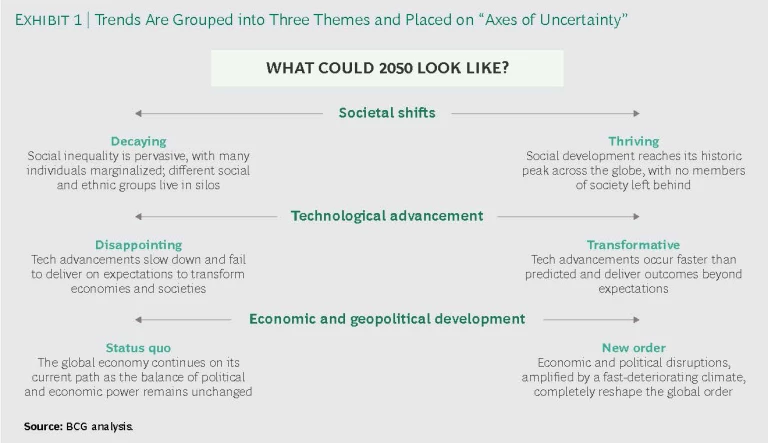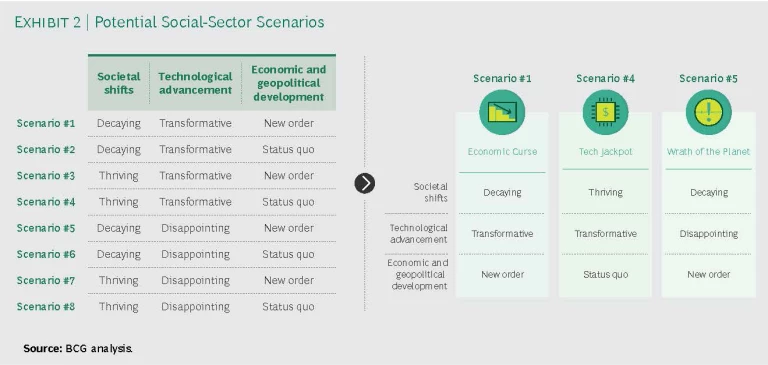A strong social sector is a prerequisite for any country’s human development and the well-being of its people. Yet as we look toward the future, we see several trends that could affect societies across the globe, including a changing climate, aging populations, rising mental health issues, and growing income inequality, to name a few. If fully realized, long-term trends such as these could eventually threaten social-sector stability, put greater pressure on governments’ fiscal sustainability, reduce overall economic growth, and negatively affect the well-being of individuals, especially those who are most vulnerable.
Given the extent of the potential impact, it’s clear that scenario planning for the social sector should be high on government agendas.
Scenario-planning exercises focus on the contingencies of current trends and are used to identify actions that governments can take now to prepare their societies for the future.
Scenario-planning exercises focus on the contingencies of current trends and are used to identify actions that governments can take now to prepare their societies for the future. Accordingly, they typically do not cover black swan events—which are not the result of long-term developments—such as the coronavirus pandemic or natural disasters not induced by climate change. However, scenario planning could still generate positive outcomes that prepare governments to deal with one-off events when they do occur; the actions governments take as a result of scenario planning often strengthen overall resilience.
It’s Not Too Late to Prepare
As part of a “future foresight” exercise, BCG looked at the driving forces, structures, and enhancers of the social sector to determine what may happen over the next 30 years. This is a sector whose organizations address multifaceted, often interlinked issues, including health, income, education, families, the environment, and community engagement. Social-sector organizations work with a broad spectrum of individuals, from senior citizens and people with disabilities to vulnerable children, low-income populations, and other groups with socioeconomic disadvantages.
The social sector is simultaneously affected by multiple trends that threaten its stability. Stakeholders within the social sector must anticipate and confront these disparate but converging trends, which can be organized into three broad themes:
- Societal shifts, such as aging, urbanization, mental health, and the role of women and the family
- Technological advancement, including genetic engineering, digital media, AI, machine learning, automation, and robotics
- Economic and geopolitical development, including climate change, migration, and income inequality
A look at global forecasts indicates how some of these trends may evolve up to 2050. The aging of the global population, for one, could change the structure of society and the workforce, as 1 in 6 people worldwide will be over the age of 65 by 2050, up from just 1 in 11 in 2019, according to recent United Nations projections. The UN also predicts that fertility will decline to 2.2 births per woman in 2050, from just under 2.5 in 2019. In the wake of a rapidly aging population, this downward trend could imbalance our ability to support the most vulnerable populations.
In addition, the Organisation for Economic Co-operation and Development (OECD) expects over 30% of jobs to be radically transformed by automation in the next 15 to 20 years, a trend that could trigger the social marginalization and exclusion from work of those without the necessary technical skills to compete. And climate-induced resource and food scarcity could affect the physical and mental well-being of entire populations, as 70% of cities will likely experience a change in climate conditions by 2050, according to a Crowther Lab study.
Scenario Planning Is a Powerful Tool
These trends and their impact on the social sector naturally carry a great deal of uncertainty. They might continue in their current direction or move in a different or opposite one, depending on a multitude of factors. No matter the scenario, however, governments need to be ready if they are to protect and provide for their citizens and societies.
No matter the scenario, governments need to be ready if they are to protect and provide for their citizens and societies.
Scenario planning is a powerful tool in this regard. It allows governments to look at key relevant trends and uncertainties, imagine sequences of possible events that could occur, and identify sets of actions they can take today to prepare for potential scenarios that can eventually come to pass. We recommend the following three-step scenario-planning process for the social sector.
Identify and Analyze Trends Affecting the Social Sector
Governments should begin by looking closely at the trends touching on their countries’ unique social sectors and the uncertainties those trends create. An aging population, for instance, may place a substantial burden on governments through rising pension and health care expenditures. Recent OECD forecasts show that by 2060 expenditures on issues related to aging may increase the public debt burden by around 180% of GDP in G20 advanced economies. At the same time, the aging populace could continue to work and contribute, potentially becoming a new source of economic growth and creating a booming “silver economy.”
Future technology advancements, in turn, could either be transformative or disappointing. For example, between 2018 and 2025, according to Allied Market Research, the global genetic testing market will grow by approximately 11% per year. By 2050, personalized gene therapies could therefore be widespread, with genetic engineering making many illnesses issues of the past. However, genetic engineering could also fail to deliver on its promises, achieving only incremental improvements in health outcomes.
Similarly, shifts in the economic landscape could lead to a new world order, or simply help maintain the status quo. Assuming a business-as-usual scenario in the US, Europe, and China, income inequality will increase dramatically by 2050. In fact, the World Inequality Lab projects that the share of global wealth owned by the top 0.1% will climb to around 25% (from approximately 15% currently). This trend could instead be reversed, making equal income distribution and shared prosperity a new reality.
Generate a Range of Scenarios
As the next step, governments should develop “axes of uncertainty” for each of the three trend themes. (See Exhibit 1.) These axes represent opposite extremes in the ways that trends could evolve—either by contributing to a thriving society or by exacerbating societal decay. Governments should then generate a range of potential scenarios for the future by exploring combinations of “uncertainties,” or potential outcomes.
Given that the range of possibilities is so great, planning won’t be easy, but it is essential. By forcing governments to integrate as many alternative possibilities as they can into the planning process—imagining many different outcomes rather than simply extrapolating what seems most likely to occur—this type of scenario planning is made to challenge conventional thinking and to create a spectrum of visions for what the future may hold. The exercise will help governments plan and build social sectors that are well-prepared for the coming decades, safeguarding human development and the well-being of citizens, regardless of how the trends eventually play out.
Using a combination of uncertainties, we have developed eight divergent but plausible scenarios for the year 2050. (See Exhibit 2.)
A few examples:
- Dramatic changes in the economic and geopolitical landscape, decaying societal shifts, and widespread technological adoption could result in an “economic curse.” In this scenario, misguided fiscal policies and trade wars lead to multiple waves of economic recession. Couples have fewer children, becuause they are worried about their financial future, and global fertility plunges to below current projections. A rise in fear and stress causes mental health challenges and depression to increase exponentially. Governments, strained by a flattened economy, cut back on social security spending, limiting support for the unemployed, those with low incomes, seniors, and people with disabilities. Rising income inequality leads to civil unrest. Widespread penetration of smart devices means that more and more people live in digital echo chambers, unwilling to communicate with and support one another.
- A retained status quo in the economic and geopolitical landscape, thriving societal shifts, and widespread technological adoption bring us to a “tech jackpot.” In this scenario, automation and robotics are ubiquitous, with new high-skill jobs replacing more traditional occupations, even as lower-skilled people are pushed out of work and become socially marginalized. The silver economy booms due to well-educated senior citizens continuing to work late in life, facilitated by innovative policy interventions and state-of-the-art smart technologies. Globalization continues at its current pace, increasingly interlinking economies and improving human mobility. Family ties and connections are not eroded; instead, they are strengthened by the prevalent use of new digital technologies.
- Our fifth scenario combines a new order in the economic and geopolitical landscape, decaying societal shifts, and disappointing technological adoption. In a “wrath of the planet” outcome, climate change eventually leads to resource shortages and civil unrest across the countries most at risk for climate catastrophe. Climate-induced migration reaches its peak by 2050, leaving many displaced. These shifts undermine the trust of citizens in international governance and dialogue. Governments then spend their budgets fighting climate change—leaving limited resources to support the poor and the vulnerable, who are left to care for themselves. Impeded by budget cuts and stagnate economic growth, investments in technology and innovation slow down sharply, decelerating the penetration of technology in different spheres of life. As a result, technology fails to deliver on its promise of improving the well-being and social integration of vulnerable and marginalized groups.
Identify Actions to Help Prepare
Once they have generated a broad range of potential scenarios, governments should contemplate how best to anticipate them well in advance, then identify no-regret actions they can begin to take immediately. We have identified several actions that are relevant to all eight scenarios noted above, and though their applications would necessarily vary, each can be deployed to help governments build capabilities and prepare for the future.
- Make public institutions more agile, enabling them to act quickly as the structure of the social sector changes. For example, the UK Department for Work and Pensions has established agile design-and-delivery teams for the implementation of its universal credit scheme, which seeks to provide a single source of benefits for adults who live off a low income or are out of work. These teams used agile ways of working, including an iterative, sprint-based development cycle, to improve service delivery.
- Use data and technology to create more targeted service provisions for the social sector. For example, Turkey’s government created an integrated social assistance system that includes an electronic database capable of compiling information from approximately 30 government agencies. Employees from different government agencies used the database to raise red flags around issues such as family violence and the school dropout rate and to redirect flagged cases to the relevant authorities. In another example, Singapore piloted smart-home technology—the Smart Elderly Alert System—to remotely monitor the elderly, reducing the need for caregivers and social workers in the home.
- Introduce more programs to encourage the engagement of nongovernment stakeholders, such as private-sector and nonprofit organizations, to increase and diversify funding for the social sector. In many developed countries, for example, governments engage in social impact bond (SIB) schemes with private investors and service providers to jointly fund social projects. The Netherland's Ministry of Justice and Security, for one, funded SIBs for the provision of social rehabilitation services to inmates. In Scotland, the government partnered with a group of real estate companies to coinvest in a fund that provides affordable housing for people on low incomes.
- Develop new mechanisms that encourage citizens to support one another, unlocking the potential of community support. A new program in Scotland encouraged residents to contribute to community development through bond investments of £50 or more directed toward social enterprises. And the Netherlands encourages people to help each other through a “time bank” that lets them trade services in exchange for “community currency,” or hours of work, instead of money.
- Scale up campaigns that raise awareness about the importance of well-being, whether for individuals or society, to prevent social issues from growing. In the UK, for example, the Duke and Duchess of Cambridge and Prince Harry led a nationwide campaign via the Royal Foundation with the goal of ending the stigma surrounding mental health.
- Build a strong pipeline of social workers and volunteers by introducing improved incentives to join the social-sector workforce. This pipeline can help bridge the gap in available support for socially disadvantaged people. In the UK, for instance, the “Every Day Is Different” campaign played on the emotional rewards of care work to recruit young people into the social sector. And in Singapore, the National Social Work Competency Framework helps potential workers understand the demands of social work by listing the knowledge and skills required at every step of a career in the field.
- Constantly monitor trends in the social sector to allow for a prompt response. In New Zealand, for example, the government created the Living Standards Framework Dashboard— which monitors the well-being of the country’s citizens across 12 dimensions, including social connections, civic engagement, and health—to promptly identify needs and challenges.
While the evolution of the sector over the next few decades remains uncertain, scenario planning will help governments prepare for any eventuality, benefit from upside opportunities, and alleviate downside risk.
Governments Should Start Future-Proofing Now
While some governments have already begun to run scenarios, this type of planning is not yet very high on the typical government agenda and rarely—if ever—involves the social sector. While the evolution of the sector over the next few decades remains uncertain, scenario planning will help governments prepare for any eventuality, benefit from upside opportunities, and alleviate downside risk. A thriving social sector could be the greatest legacy of current governments if they remain vigilant, plan responsibly, and start future-proofing immediately.











